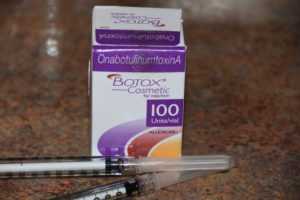
The simplicity of any treatment does not necessarily guarantee a good result. In most cases, it is difficult to not chose Botox as a correct treatment for undesired lines and wrinkles from hyperactive or normal facial expressions. Whether it is the glabellar furrows or crow’s feet, Botox is always the first (and really only good) treatment of choice. Below the eyes, however, Botox is often not the only or even the best treatment for wrinkling problems around the mouth and neck. Most times, the mouth and neck are better off with either other minimally-invasive treatments or actual plastic surgical procedures. The problem is….if all you have in your treatment bag is Botox or a few injectable fillers….a patient’s result will not only be limited and disappointing but a waste of a patient’s money.
For Botox to be maximally effective, it must be mixed properly and used relatively promptly. Botox comes as a powder in a bottle that is so minute it is virtually impossible to see. It is reconstituted with saline on-site and, although the manufacturer provides recommendations as to how it is to be mixed (how much saline is put into the bottle), the treatment provider can do as they will. Because of profit margins involved, it is tempting for some to create a ‘dilute’ Botox mixture by adding more saline than the manufacturer recommends. This creates more Botox available to be injected and a greater number of patients can be treated….but it usually doesn’t work as well, if at all, and it lasts a shorter period of time. You the patient would have no idea whether the Botox you received was diluted…and I have found most patients don’t even know how many units they have or usually receive. They simply know the price they paid.
The other factor that affects the effectiveness of Botox is how long after it is mixed is it used. Botox is not like wine….age does not make it better. After it is mixed it should be used within 24 to 48 hours at the longest. While the manufacturer recommends hours to a day, a day or two after mixing does not seem to change its effectiveness. How ‘old’ the Botox you have received is unknown to any patient. One indication that the Botox you may receive is fairly fresh is how busy is the practice or location where you receive it. (how often do they do Botox treatments) Daily? Weekly? Monthly? The busier a practice is, the more likely they will have fresher Botox.
Botox is a remarkable medical treatment that offers unparalleled wrinkle-reduction results in the forehead and around the eyes. While it is a simple injection treatment, its results can be affected by the training and experience of the injector and how it is reconstituted and when after it is used. As an Indianapolis Botox injector, I always mix accoroding to the manufacturers recommendations and use the entire bottle within 48 hours.
Dr. Barry Eppley
Indianapolis, Indiana


